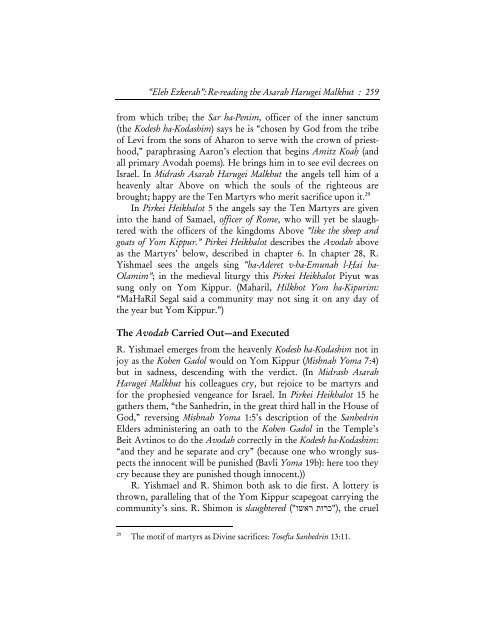“Eleh Ezkerah”: Re-reading the Asarah Harugei Malkhut - Hakirah
“Eleh Ezkerah”: Re-reading the Asarah Harugei Malkhut - Hakirah
“Eleh Ezkerah”: Re-reading the Asarah Harugei Malkhut - Hakirah
You also want an ePaper? Increase the reach of your titles
YUMPU automatically turns print PDFs into web optimized ePapers that Google loves.
<strong>“Eleh</strong> <strong>Ezkerah”</strong>: <strong>Re</strong>-<strong>reading</strong> <strong>the</strong> <strong>Asarah</strong> <strong>Harugei</strong> <strong>Malkhut</strong> : 259<br />
from which tribe; <strong>the</strong> Sar ha-Penim, officer of <strong>the</strong> inner sanctum<br />
(<strong>the</strong> Kodesh ha-Kodashim) says he is “chosen by God from <strong>the</strong> tribe<br />
of Levi from <strong>the</strong> sons of Aharon to serve with <strong>the</strong> crown of priesthood,”<br />
paraphrasing Aaron’s election that begins Amitz Koah� (and<br />
all primary Avodah poems). He brings him in to see evil decrees on<br />
Israel. In Midrash <strong>Asarah</strong> <strong>Harugei</strong> <strong>Malkhut</strong> <strong>the</strong> angels tell him of a<br />
heavenly altar Above on which <strong>the</strong> souls of <strong>the</strong> righteous are<br />
brought; happy are <strong>the</strong> Ten Martyrs who merit sacrifice upon it. 29<br />
In Pirkei Heikhalot 5 <strong>the</strong> angels say <strong>the</strong> Ten Martyrs are given<br />
into <strong>the</strong> hand of Samael, officer of Rome, who will yet be slaughtered<br />
with <strong>the</strong> officers of <strong>the</strong> kingdoms Above “like <strong>the</strong> sheep and<br />
goats of Yom Kippur.” Pirkei Heikhalot describes <strong>the</strong> Avodah above<br />
as <strong>the</strong> Martyrs’ below, described in chapter 6. In chapter 28, R.<br />
Yishmael sees <strong>the</strong> angels sing “ha-Aderet v-ha-Emunah l-H�ai ha-<br />
Olamim”; in <strong>the</strong> medieval liturgy this Pirkei Heikhalot Piyut was<br />
sung only on Yom Kippur. (Maharil, Hilkhot Yom ha-Kipurim:<br />
“MaHaRil Segal said a community may not sing it on any day of<br />
<strong>the</strong> year but Yom Kippur.”)<br />
The Avodah Carried Out—and Executed<br />
R. Yishmael emerges from <strong>the</strong> heavenly Kodesh ha-Kodashim not in<br />
joy as <strong>the</strong> Kohen Gadol would on Yom Kippur (Mishnah Yoma 7:4)<br />
but in sadness, descending with <strong>the</strong> verdict. (In Midrash <strong>Asarah</strong><br />
<strong>Harugei</strong> <strong>Malkhut</strong> his colleagues cry, but rejoice to be martyrs and<br />
for <strong>the</strong> prophesied vengeance for Israel. In Pirkei Heikhalot 15 he<br />
ga<strong>the</strong>rs <strong>the</strong>m, “<strong>the</strong> Sanhedrin, in <strong>the</strong> great third hall in <strong>the</strong> House of<br />
God,” reversing Mishnah Yoma 1:5’s description of <strong>the</strong> Sanhedrin<br />
Elders administering an oath to <strong>the</strong> Kohen Gadol in <strong>the</strong> Temple’s<br />
Beit Avtinos to do <strong>the</strong> Avodah correctly in <strong>the</strong> Kodesh ha-Kodashim:<br />
“and <strong>the</strong>y and he separate and cry” (because one who wrongly suspects<br />
<strong>the</strong> innocent will be punished (Bavli Yoma 19b): here too <strong>the</strong>y<br />
cry because <strong>the</strong>y are punished though innocent.))<br />
R. Yishmael and R. Shimon both ask to die first. A lottery is<br />
thrown, paralleling that of <strong>the</strong> Yom Kippur scapegoat carrying <strong>the</strong><br />
community’s sins. R. Shimon is slaughtered ( " ושאר תורכ"<br />
), <strong>the</strong> cruel<br />
29 The motif of martyrs as Divine sacrifices: Tosefta Sanhedrin 13:11.

















